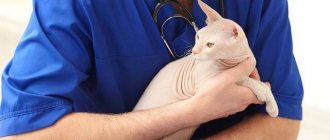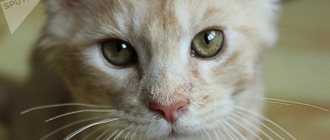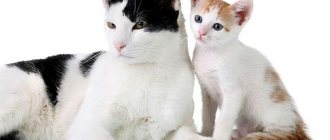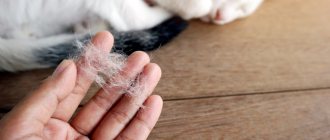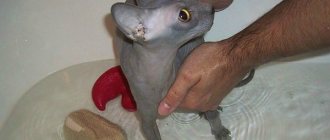Typically, the need to determine the age of a kitten arises if it is thrown or given as a gift. If with a “gift” things are much simpler, you can ask and get information from those who gave the gift, then with a foundling (or picked up on the street) everything is much more complicated. There is also no question if this baby is from the lambing of your own cat. A dropped or picked up kitten needs certain care, vaccination and feeding. Here, not only months, but even days are of great importance, because nutrition will have to be selected according to his age. How to determine the age of a kitten? There are a number of ways, which are described below.
Why is it important to know the kitten's age?
Experienced breeders and veterinarians can tell a kitten's age without having exact dates. The process of socialization in kittens begins around two weeks of age and continues until almost two months. It is at this time that you can understand how playful or reserved the kitten is, and how it will get along with people. If the animal has a wild or aggressive character, most likely this will not change in the future.
Foundlings
Kittens of any age are adorable, no matter what breed they belong to. However, it is very important to know when they were born in order to provide them with the correct care and care. As a rule, five signs are enough to independently determine the age of a kitten:
- body size and proportions;
- color and shape of eyes and ears;
- pet's weight;
- number and condition of teeth;
- behavior and activity.
Who can confirm our assumptions?
If you are not an expert, or at least have not had cats in your home before, it is very important to verify your assumptions about the age of your pet.
There are two ways out:
- Contact the breeder
The former owner or breeder has been watching your new friend since his birth.
Therefore, the first owner will probably advise you accurately at the age of the kitten.
However, what to do if your pet is found on the street?
- Let's go to the veterinarian
Of course, it is an experienced specialist, and especially a specialist in small animals, who can easily but accurately tell you the age period of a young four-legged pet.
In addition, even if you have dealt with cats before, the help of a veterinarian can never be superfluous.
Sexual characteristics appear in cats from birth.
How to determine how many days or months a furry pet is: useful tips
It doesn’t matter whether your new pet is purebred or a foundling without a family or breed - there are many ways to determine the age of a kitten that do not require a special approach or veterinary education, just an attentive and caring attitude.
If the kitten is still very young, and is no more than three days old, it still has an umbilical cord, which usually falls off in the first few days. The cat gnaws the umbilical cord and licks the kitten, thereby massaging it and calming it. It is not advisable to pick up kittens before they are two weeks old.
Kittens with mom
You can roughly guess the age of a kitten based on the proportions of its body. A three-week-old kitten has a large head, short legs and small ears. Their coordination of movements at this time is poor, and they spend a lot of time trying to gain control of their paws and body. By one month they become slightly more proportional, and after another month the body becomes longer. By three to four months, their ears lengthen, the kittens become restless and active. Starting from four months, the kitten begins to lose its cute childish features and roundness, and stretches out, even if it gains weight normally.
Behavior Observation
This is a very indirect sign, so it is problematic to find out the real age only by observing the life and habits of the animal. In addition, the cat’s temperament, breed, condition and environment have a certain influence. So is it possible to determine the age of a cat by its behavior? For sure - no, rather, this is a clarifying factor.
Kittens are the most active
A young animal is much more active than an older one. The highest activity is in kittens who are ready to play, jump, and tumble all day long. As they get closer to a year, they become calmer, although some breeds are famous for their playfulness at a very mature age. A cat older than a year will prefer to lie down imposingly on a sofa or windowsill, condescendingly watching what is happening.
An older animal sleeps much more and prefers not to move in vain. But a sick animal will behave in approximately the same way, preferring peace. Therefore, behavioral factors alone will not give an accurate answer to the question of how to determine the age of a cat.
An older animal sleeps much more
Is it possible to find out the age of a kitten at home?
It’s one thing if a kitten is given as a gift or found, and you yourself become its mother, feeding it from a bottle. It’s a different matter when babies grow up with their mother, and you have the honor of witnessing this touching process. One fine day, your cat, who has often been away from home, suddenly returns with a new addition in her teeth: a tiny ball of hair, or more often than not, several. In addition to being a joy, this can cause some confusion, especially if you are not great at raising kittens. One of the questions that arises is: when exactly were they born, and how to find out? Observation and examination of babies can clarify the situation.
A cat usually begins to wean her kittens off her milk when they are a month and a half old.
This is easy to notice: she will increasingly leave them and leave when the kittens attach themselves to her nipples. However, there are cats that do not stop feeding for up to three months. There are also cats who do not feed their kittens from the moment of birth.
How to feed a newborn kitten if the mother cat refuses to do so
Kittens appeared in your house
Kittens up to two weeks of age move little; they usually sleep almost all the time and drink milk, and occasionally crawl on their stomachs. When they are two to three weeks old, they begin to walk more confidently. By three weeks, they develop an interest in moving objects, they begin to play with rustling pieces of paper and roll small things across the floor. At the age of about a month, they learn to deftly turn over in the air and fall on their paws.
Video - Kittens learn to walk
Closer to two months of life, kittens begin to increasingly explore the world around them, become mobile and increasingly leave their mother, causing her to worry. They often climb a tree, although at first they do not know how to descend, and at this time you need to carefully monitor their movements, because sometimes furry pets overestimate their strength and can get seriously injured if they fall. This is the most restless period for a cat, because you have to watch the children all the time. If the kitten runs confidently and quickly, it is more than five weeks old. It is at this time that a healthy kitten, receiving normal nutrition and care, begins to gain confidence in their abilities because coordination improves, they begin to explore the house, communicate with people and animals, and can make friends with the dog if it is peaceful. At this time, the mother cat vigilantly monitors the dog’s behavior and fearlessly attacks at the slightest threat to the children. Kittens love to play with toys, throwing them and catching them, scratching with their claws and chasing them. Who else can wake you up with the rustling sound of little paws on the floor and make you smile with tenderness?
Little friends
Behavioral Assessment
Finding out the age of a pet is much more interesting and enjoyable by its behavior, actions, and inclinations to play. The fun of furry cubs evokes affection even among the most stern representatives of humanity. An attentive owner will understand how many weeks old his pet is by simply observing his lifestyle, taste habits and behavior.
Ability to jump to heights
The baby begins to make his first attempts to walk when he is 10-12 days old. At first he has difficulty standing on his feet and sways even while sitting. Gradually, the curious mustache takes longer walks, confidently moving around the room.
By the end of the first month, the curious fluffy masters running and jumping, and also tries to climb vertical surfaces with the help of his claws. The little researcher begins to jump to heights more and more actively, practicing his skill every day. When he falls off the couch, he usually manages to roll over and land on his paws.
Ways to play
As soon as the kittens begin to stand confidently on their feet, it’s time for unrestrained games. They run around the house, knocking over objects and even mother in their path. They are interested in everything: a rustling piece of paper, a dangling thread, a dropped leaf. Kids actively play with empty plastic bottles, chasing them from corner to corner. This characterizes one and a half to two month old babies.
Over time, the nature of games changes. Children learn how to hunt: their prey includes slippers, shoelaces, and the feet of family members. The hunting age is 3-4 months.
Excessive activity is typical for babies under six months of age. Gradually, fun turns into conscious play.
Eating food
If there is such an opportunity, then you need to observe the mother feeding the baby. The behavior of the mother cat will tell you how to find out the approximate age of the kitten.
Until six weeks, the mother does not restrict the children from sucking milk. By ten weeks the baby begins to feed independently. During this period, the owner needs to feed the mustache using liquid porridge or suitable wet industrial food.
Gradually, coarser foods are introduced into the diet. A kitten can chew small granules of dry food as early as 2-2.5 months. A six-month-old animal eats the same foods as an adult animal.
Puberty
Primary sexual characteristics can be recognized in cats immediately after birth. At four to six months, puberty begins. This period is characterized by a radical change in hormonal levels and, as a result, behavior. The babies begin to meow loudly and ask to go outside.
Boys tend to mark territory and attempt to mate with girls. In females, the first heat begins between six months and a year - the norm is different for all breeds. For mestizos this is an average of 8-10 months. In large breeds, puberty occurs a little later than in small breeds.
The cats meow loudly, rub against a person’s legs, wriggle their whole bodies, and try to escape. If the cat will bear offspring, then mating is postponed until the third heat. If not, it is better to sterilize it. The same applies to males.
When furry pets open their eyes
You can quite accurately determine how old a kitten is by examining its eyes. Kittens are born blind and usually open their eyes on the tenth to twelfth day, but not earlier than a week after birth. In healthy kittens up to two weeks old, the eyelids are tightly closed or slightly open, and there is no opaque discharge. At the same time, the eyes will remain cloudy and bright blue for some time, and only then will they begin to change their color to “adult” - unless the breed of cat assumes that they will remain blue-eyed (Angora, Siamese, British and others). Blue eyes mean that the kitten is not yet two and a half months old. Typically, the eye color of cats is green or yellow, sometimes amber. The color is finally established by the age of six months. You can also look at the babies' ears. At birth, kittens' ears are pressed tightly against their head, as kittens are born with closed ear canals. They open no earlier than the fifth day of life, and the kittens begin to hear; The ears lift completely in the second or third week.
Newborn kitten
Show your teeth baby
A good way to understand how old a kitten is is to examine its teeth. To do this, you need to carefully, without using force, spread the kitten’s jaws and examine the oral cavity. Up to two weeks, kittens have no teeth at all, then the incisors begin to cut. Primary canines erupt in the third to fourth week, and premolars in the fourth to sixth week. If the kitten has a full set of teeth, but they are not molars, the kitten is approximately four months old. Should be:
- six incisors on both jaws;
- two fangs above and below;
- three premolars above;
- two premolars below.
Baby shows teeth and character
If your pet chews on things and furniture upholstery, this may be due to teething. If the kitten already has large teeth, it is about four months old or older. There will be 26 milk teeth in total, and in a year and two months they will be replaced by permanent teeth, and four more molars will be added to their number.
An animal's behavior will tell you about its age.
Young cats are very active, playful and inquisitive. They come running to every sound and play constantly. They react to any movements and chase cat balls. It is quite easy to determine their old age (from 7 years and older). The old cat is lazy and incurious. He sleeps a lot and hardly plays. The old man is no longer attracted to his favorite toys.
If a cat gets sick, it behaves passively, despite its young age. Therefore, this method does not give an exact answer to how old the cat is.
Exceptions to the rules
Despite the variety of methods, there are factors that can interfere with correct calculation:
- Heredity.
The individual characteristics of the animal in appearance and behavior may not correspond to age standards. - Presence of diseases.
Poor health and exhaustion of a cat can affect its behavior and appearance. - Conditions of previous content.
If a cat previously lived in street conditions and did not receive the necessary vitamins, in appearance it will look much older than its domestic relatives.
How much does a kitten weigh?
Since different breeds of cats can have different weights, determining the age of a pet using this parameter can be difficult, and the result will not be accurate, but this method is suitable for an approximate determination. Typically, kittens weigh about 100 grams at birth, and begin to gain weight by 10-20 grams daily. At this time, kittens only need warmth and food, they hardly move and wake up only to eat.
In the first days after birth, kittens need only warmth and food.
Their approximate weight is:
- 120-175 grams – in two weeks;
- 180-230 grams – in three weeks;
- 235-260 grams – at four to five weeks;
- 670-910 grams - at seven to eight weeks (weight gain by this time slows down somewhat, because kittens at this age become active and move a lot).
If your pet looks healthy and has not had any sudden weight gain or loss, then it is not necessary to weigh him. However, this may be required, for example, in cases where:
- you need to calculate the daily amount of food for the kitten;
- you need to calculate the dose of medications or vitamins.
Let's get on the scales
It should be understood that accurate knowledge of the kitten’s age is important in order to prescribe the correct diet for it and not try to feed a very tiny baby with meat, or, on the contrary, feed an active teenager only milk. Of course, if fed incorrectly, your pet's health can deteriorate sharply. The simplest and most relaxed way of weighing for a kitten and its owner is when the owner picks it up and stands on the scales, then weighs himself and subtracts the second number from the first. Of course, a kitten's weight and the rate at which it gains weight depends on many factors, including:
- how the cat ate during pregnancy;
- how many kittens were born at one time;
- what breed of kitten;
- what gender he is (females gain weight more slowly).
After three months, a kitten gains about 500 grams per month until the weight is approximately 4 kilograms - this is already the average weight of an adult animal. You can also focus on the kitten’s body length:
- a newborn has a body length of 10-12 cm excluding the tail;
- 1 month – 13-15 cm;
- 2 months – 16-18 cm;
- 3 months – 18-21 cm;
- 4 months – 21-23 cm;
- 5 months – 23-25 cm;
- 6 months – 25-27 cm.
Measuring the body length of a grown kitten
Why do you need to know the age of a kitten?
It is difficult to imagine a situation where there is any practical sense in clearly establishing the age of a pet. The dosage of food or medicine for cats (as well as for people) is calculated by weight, the date of birth of breeding animals is indicated by the breeder in the accompanying documents (in the pedigree and veterinary passport), and if the kitten was picked up on the street, it doesn’t even matter. how many weeks or months old he is.
Determining the exact age of stray kittens is unlikely to make practical sense
This is how our first cat came into the house. My father brought it, warming him from the severe frost on his chest. The little creature had not yet learned to walk and swayed funny on its weak legs. The unfortunate child also did not know how to feed himself, and we took turns feeding him with milk formula from a pipette, without thinking at all about the age of our new pet. Somehow, imperceptibly, an adult robber grew out of a tiny lump, who amused himself by closing the valve in the bathroom from the inside with his paw, scaring everyone in the household to death (we thought a thief had broken in with us), in a word, the question of how many weeks the baby was originally lost its relevance very fast.
There are situations when the lack of basic ideas about what kittens look like at a given age can cause quite certain inconveniences, but this applies primarily to expensive purebred animals.
Once, a potential buyer, negotiating with the author the conditions for purchasing an Abyssinian boy, asked to send him a video in which he could see the kittens, and after studying the recording, he hesitantly asked whether the babies were really only three months old, since they supposedly looked six months old.
Three-month-old kittens differ from their parents only in size
Experts know well that by the age of three months, kittens differ from adult animals only in size, but even this difference can only be noticed when there is a “sample” nearby for comparison. The association of felinological clubs World Cat Federation (WCF) categorically does not recommend separating kittens from their mother before they reach three months of age. Because of this requirement (absolutely justified, by the way), one can often encounter a situation where, seeing in front of him not a kitten, but a small cat, the buyer believes that they are trying to sell him an overgrown animal, although in fact this is not the case.
Let's give another specific example of a situation where the ability to determine the age of a kitten by external signs will help you avoid becoming a victim of scammers.
How to understand how many months a kitten is
At about six months, kittens begin to fight each other in an attempt to determine who is stronger. It should be remembered that teenagers bite more often than children or adult animals, and you need to be more careful when interacting with your pet. At the age of seven months, kittens are considered sexually mature and become larger and more aggressive. If you try to convert the age of a kitten to a human equivalent, then the first year of a cat’s life is equal to approximately 14-18 human years, then seven “human” years are added every year.
Comparative table of cat and human age
Cat's age by eyes
The age of a cat can be determined by its look. If for young cats the manifestation of interest and curiosity in their gaze is considered a sign of good health, then for mature cats a calm and attentive gaze becomes the norm.
Just like in humans, in cats, along with other age-related changes, the lens of the eye acquires characteristic features. With return, it fades, which can be explained by the possible development of cataracts. The iris, which also fades with age, also leaves its mark on the cat’s gaze, sometimes spots or patterns appear on it.
Purulent discharge from the eyes is a common problem in older cats. An animal's immunity to infections weakens somewhat with age, so if there is discharge or increased tearing, you should contact a veterinarian. Of course, young cats can also have an eye infection, but older furry pets suffer from this disease much more often.
Tips on how to distinguish a cat from a cat
Primary signs of sex in cats can be distinguished from birth. You can examine the kitten yourself, tactilely or visually. In the first case, you need to wash your hands thoroughly, make sure they are not cold, and place the kitten in your palm. If the baby is wary or worried about something, it is better to leave the check. The second way is to simply look at the genitals and anus. In a male they closely resemble a colon, while in a female they resemble an exclamation point. In addition, cats can boast of quite thick hair between these “points”, unlike female cats. Experienced cat lovers can determine gender by the shape of the face and body:
- the cat has a wider muzzle and nose;
- his physique is more massive, his paws are thicker;
- the cat is more graceful;
- Cats have an elongated muzzle.
Boy and girl
Calico cats are almost always (with very rare exceptions in the form of a genetic disease) cats, since the calico gene is associated with the X chromosome, which only girls have. When kittens are four to five months old, they begin puberty and their hormonal levels change dramatically. They may ask to go outside and meow loudly. Males tend to mark territory and may try to mate with females. Females can experience all the delights of the first heat, during which, under the influence of awakened hormones, they begin to scream loudly, rub their muzzle against the owner’s legs, and squirm. However, it should be remembered that early pregnancy is undesirable for a cat.
Correlation between human and cat ages
The desire to convert human years into cat years has probably driven man for more than a hundred years. Since it is hardly possible to draw an unambiguous analogy between the age of a person and the age of a cat, people resort to various tricks in order to identify a scheme by which it would be possible to approximately calculate the age of a cat.
Converting human years to cat years presents a number of difficulties.
The most common scheme allows you to calculate the age of a cat by multiplying the number of light years it has lived by 7. Of course, such a calculation system has errors and does not suit many people.
Problems of transferring human standards
The question of how legitimate the ambitious desire to calculate the exact age of a cat by human standards remains open. It is important to remember that cats develop in ways that are fundamentally different from humans.
The development rates of the cat's body and the human body have little in common with each other
Yes, cats go through phases of “infancy”, “childhood”, “adolescence”, “youth” and “maturity”. Blooming and fading are characteristic of them in the same way as other living organisms. Meanwhile, one can hardly derive any practical benefit from the assumption that Nikolai the cat is 35 cat years old. However, such methods of calculation allow the owner to “bring the animal closer” to himself and make it more understandable from a human point of view.
We should not forget that attempts to transfer the peculiarities of emotional perception, thinking and other psychological characteristics of a person to a cat are only a projection that has a distant relationship to reality.
A comprehensive ratio of cat and human ages is shown in the table below.
Cat to human age ratio
Scottish kittens
For owners of Scottish cats, the issue of kitten weight is especially important, because the status of the animal largely depends on it. Scots are calm, rather stocky, and in size they can be placed in the middle between large Maine Coons and, for example, Siamese.
Little Scotsman
They tend to overeat, so their weight needs to be carefully monitored. Up to six months, Scots gain weight quite quickly, then this process slows down. The weight standards are:
Table 1. Weight standards for Scottish breed kittens.
| Scottish kittens | Weight, g | |
| Floor | Boys | Girls |
| Newborns | 75-145 | 60-135 |
| 1 Week | 245-285 | 115-250 |
| 2 weeks | 345-410 | 130-370 |
| 3 weeks | 390-730 | 210-410 |
| 1 month | 800-1710 | 250-610 |
| 2 months | 1510-2520 | 405-910 |
| 3 months | 2690-3890 | 1010-1500 |
| 4 months | 2590-4300 | 1705-2400 |
| 5 months | 3000-5390 | 2200-2890 |
| 6 months | 3310-5710 | 2310-3600 |
Teeth
The age of both very small and adult individuals can be determined by the teeth. Teeth begin to grow at 2-3 weeks, and fangs appear at 3-4 weeks. Next, the premolars erupt. If the baby has molars, then he is more than 8 weeks old, and if 4 molars have already grown, then he is at least 7 months old.
An adult cat has 30 molars, including: 12 incisors, 10 premolars, 4 molars and canines.
By the age of one and a half years, the teeth turn yellow, the incisors begin to wear out, and at the age of 5-5.5 years the same fate befalls the fangs. After 10 years, loss of incisors is noted, and from 14-15 years the animal also loses its fangs.

